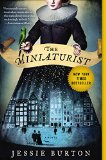Page 1 of 1
There are currently 3 reader reviews for The Miniaturist
Write your own review!
M.Shaw
The Miniaturist
Very good read. Didn’t want to put it down. A good representation of life in the Netherlands in the 1600s. Some twists and turns you didn’t see coming, too.
 Cloggie Downunder
a brilliant read
Cloggie Downunder
a brilliant read
The Miniaturist is the first novel by British author, Jessie Burton. Amsterdam in the late 1680s is a prosperous place for merchants of the VOC (Dutch East India Company). When eighteen-year-old Petronella Oortman, newly married to wealthy merchant, Johannes Brandt, arrives at his luxurious home on the Herengracht, she is nervous but expectant: surely her life can only get better now that she has left Assendelft.
But Johannes is absent, and his sister Marin is less than welcoming. When her husband finally returns, things do not go as Nella had expected. He does, however, bring her a remarkable gift: a replica of their home in miniature. She engages the services of a miniaturist to craft items to furnish this amazing creation, but is disturbed by the accuracy of certain extra pieces, pieces she did not order.
As Nella becomes familiar with the household, it is soon apparent that neither people nor circumstances are what they first seem, and that the life she had expected, and perhaps even hoped, for is unlikely to be the one she will have. Before long, she discovers the shocking truth about her marriage, learns disturbing facts about her husband’s business dealings, surprising truths about other household members and about the elusive but seemingly prescient miniaturist.
Nella begins to realise that while there is abundant prosperity, there is very little tolerance in this Amsterdam “Where the pendulum swings from God to a guilder”. Within three months, this young innocent country girl has to draw on reserves she was unaware she had, along the way witnessing a drowning, a stabbing and a sexual act, attending a funeral, seeing a man condemned to death, bribing a prison guard, and handling the sale of a valuable commodity.
As she weaves a fictional world around real life characters, Burton also provides the reader with a wealth of information about late seventeenth century Amsterdam. Her extensive research is apparent in every paragraph. How interesting to imagine a time when sugar was rare enough to be a valuable commodity, and to actually view Nella’s cabinet house in the Rijksmuseum.
Burton also treats the reader to some marvelously evocative descriptive prose: “A spray of red pimples covers the second man’s forehead. He’s little more than a boy. God has been malicious with his paintbrush” and “The threads of Nella’s imagination begin to spool, embroidering conversations, patches of which it stitches loosely together” and “There is water everywhere she looks, lagoons as still as glass, patched with murk like a foxed mirror when the weak sun moves behind cloud” are just a few examples. This amazing debut novel is a brilliant read. 4.5 stars
JudithG
Too Much for a Small House
Amsterdam, in the late 17th century, is a city of hidden opulence and religious repression. Eighteen-year-old Nella Oortman enters a prosperous, but sham marriage, with the merchant Johannes Brandt. When her husband presents her with a replica cabinet house, she finds that the mystery and deceit that surrounds her is duplicated in the miniatures she acquires to furnish the house. If this book had been a simple romantic coming of age story, I would have no quarrel with it. This is an interesting historical setting and I cared about eventual outcome for these characters. The quality of the writing holds up well enough for a summer beach read, but given the heavy thematic content of the plot, I was looking more.
It’s likely that my expectations were too high. The historical setting brings Chevalier’s Girl with a Pearl Earring to mind. The level of deceit and secrecy in the household made me think of The Thirteenth Tale by Diane Setterfield. I looked for that level of excellence in the prose, and I didn’t find it. The title of the book lead me to believe that the miniaturist would be an active character. In fact, she becomes a rather awkward plot device that doesn’t quite achieve the level of magical realism. This book is full of complex themes, probably too many of them. The author’s treatment of the religious and sexual repression of the Brant siblings felt a bit too 21st century.
This book did hold my attention. I cared about these characters and their spiraling tragedy. It’s just a shame that the writing didn’t quite support the depth of their story.
I had an advanced reader copy of this book. It is set to be published in August 2014.
